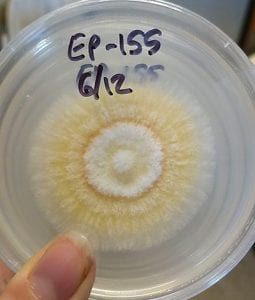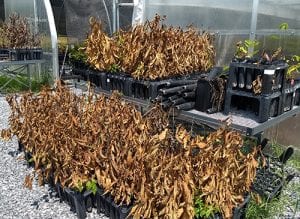
A plate of inoculum used for the small stem assay.
On July 8, TACF staff and volunteers from the southwest branch of the TACF-VA Chapter braved the heat and humidity to inoculate over 3,300 B3F3 trees for this year’s small stem assay (SSA) at TACF’s Meadowview Research Farms. Seeds for the SSA were planted in late February, and came from trees on Meadowview’s Price, Wagner, and Duncan farms, as well as from families in Tennessee, North Carolina, and Pennsylvania. In addition to sowing a large number of seeds in preparation for the SSA, a lot of Cryphonectria parasitica inoculum was prepared as well – our summer research intern and I prepared over 100 plates of inoculum (EP-155) to use for this year’s SSA at the end of June.
The assay is conducted on seedlings with a stem diameter of 3mm or larger. An approximately .5 cm wound is made on the stem around 6 cm high, and a small plug of inoculum from one of the petri plates of Cryphonectria is placed onto the wound and wrapped in Parafilm in order to infect the tree with blight. It takes about 2 – 3 weeks to begin seeing symptoms develop and cankers form.
The small stem assay allows us to see differences in blight resistance among different families, and lets us compare greenhouse results to field results. This allows us to speed up the breeding selection process – for field studies it is necessary to wait for at least three years until trees are big enough to inoculate, whereas in the greenhouse you can do inoculations, canker measurements, analysis, discard the poor performers, and see results in one growing season.

Trees that have been removed after succumbing to the chestnut blight fungus.
Each week, we inspect all the trees and remove ones that have died. This measurement is referred to as “time to wilt,” and was found to be a valuable measurement of blight resistance last year. Six, 12, and 18 weeks after inoculations, cankers on the living trees are measured as well, and other useful phenotypic traits are noted, thanks to the help of volunteers with the VA-TACF Chapter’s southwest branch. These data can provide another indicator of blight resistance and susceptibility, and give us more insight into how chestnut trees respond to the blight.
While it is a bit sad to watch all of the trees we put so much effort into growing into healthy seedlings die off (around 200-400 die each week, on average), it is very interesting to observe the host-pathogen response of the different trees and families, and see how the assay progresses over time. Also, clearing out hundreds of dead trees each week gives me the opportunity to finish out the current growing season and begin working with an empty greenhouse in late fall and winter in preparation for the next crop of trees to be grown for SSAs, field plantings, and other research and restoration projects in the coming year.
- The orange rusty color on the stem is a blight canker.

